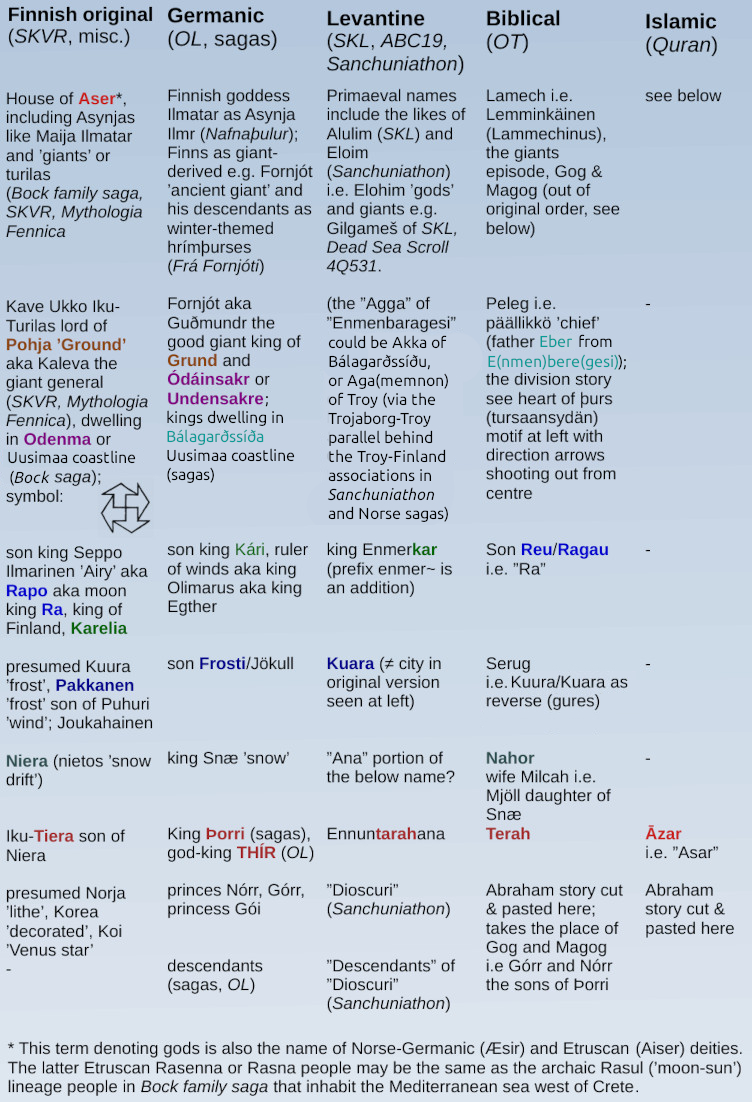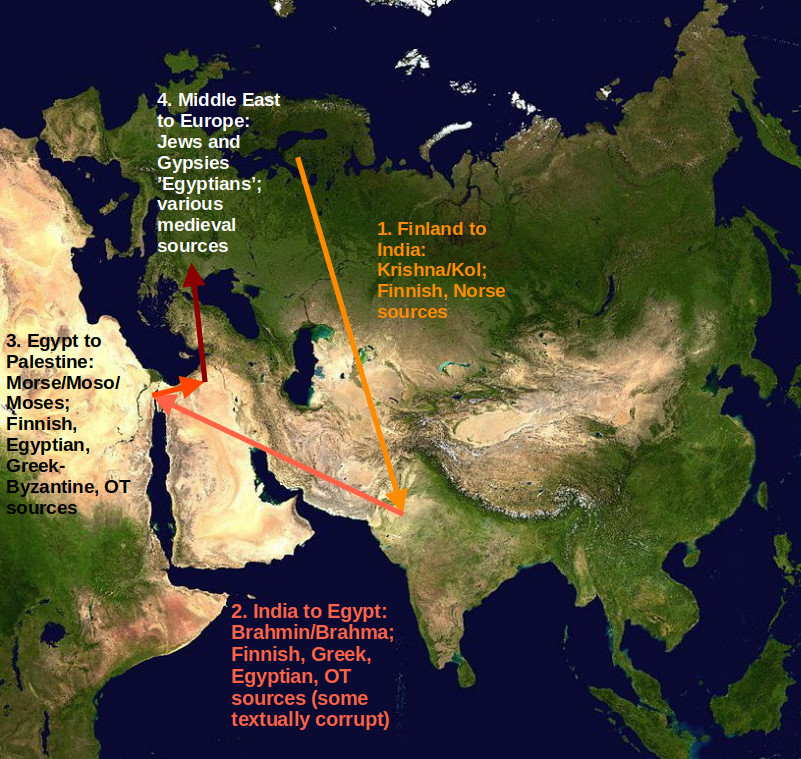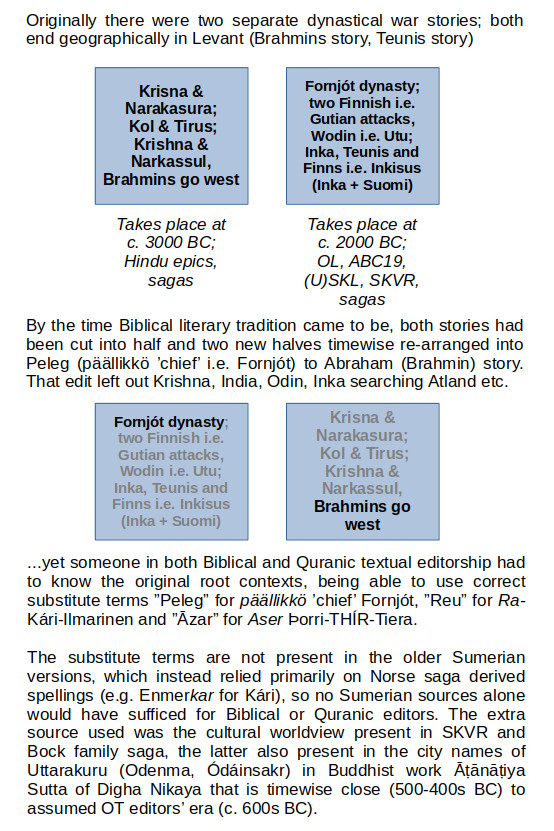This post shows how the same lineage attested in OL and Norse sagas ended up not only in Sumerian sources (SKL, USKL, ABC19), but also to Christian Bible and Islamic Quran. This all is parallel to the Alexander the Great who is found also from likes of OL, Uruk King List ("A-lik-sa-an-dar",
source) and Quran as 'Two-Horned One' seeking water of life and Atlantis (
source, the Quran name is also Bock family saga term for water of wisdom ritual).

- comparison.jpg (486.38 KiB) Viewed 5397 times
Most of the traditions put these characters into about ~2000 BC era, again evidence that once
in antiquity there existed a shared Eurasian standard chronology on what had happened. This is also incidentally the reason why some of these names and peoples (like the Gutians) are so enigmatic to Levantine scholars: they never were to begin with about Middle Eastern situations, people and places. Main arguments that the story went from north to south are a. the full 12+ sons of Kaleva (sons of Fornjót/Guðmundr) troupe in Finnish root source, b. how the Finnish system can't function without a Lemminkäinen character (Lamech/Lammechinus) whereas the character is of less importance in other traditions (even the Norse Balder dies), c. correct identifying of various Finnish characters in Levantine sources as Shu/Su/Cu for 'Finn' and Āzar for 'Aser' and d. the repeating earls episode, with earls (jarl, yarla) as northern European title.
As is evident from the comparison, some of the early Christian and Islamic editors must either had access to Finnish and Norse language sources or knew them directly. Correctly renaming Reu and Āzar, instead of using the earlier local spellings Enmerkar and Ennuntarahana, is
evidence of exact Bock family saga term knowledge. An alternative explanation is that the Reu-Serug pair is due to Egyptian army commander Reʾu or Raia (Reu) fighting Sargon (Serug) in 720s BC (
source), but this reading does not explain the presence of Frá Fornjóti loans (Nahor, Terah) or why Reu happens to coincide lineage wise exactly with Ra-Ilmarinen.
One interesting suggestion from this comparison is that
the Gog and Magog of the Biblical traditions are the "Gutians" or the Górr and Nórr armies of Frá Fornjóti and Oera Linda book. One takes the sea route and another takes the land (maa) route, hence Gog and Magog (maa-Gog, 'land-Gog'). This division is present also in the OL narrative (OL MS 051: "divided into two large groups and each went its own way. Of the one part, no account has come to us. But the other part invaded the rear of our Skeanland").
The theological (divine) retribution element is already present in the ABC19 Weidner Chronicle version, hence the same element of God using Gog, Magog and perhaps also Rosh (Russia) to punish various nations. If Magog is the 'land of Gog', then it's again a perfect match: maa-Gog 'land-Gog' in reference to the Gothic/Gutian nations, or "Gotlandi, Kænlandi ok Finnlandi" as Frá Fornjóti puts it ('Gotland/Gothland, Kainuu and Finland' in English). Wikipedia has two good articles (
one,
two) about the whole topic. Note that in the Hindu account the two generals Koka and Vikoka battle Kalki. It just happens that in Fundinn Noregr, variant of Frá Fornjóti, the Nórr and Górr oppose one king Sokni of Sogn (
source) - that Germanic name form is in Finnish form Soini (son of Kaleva-Iku-Turilas-Fornjót-Guðmundr), whose alternative name is Kalkki (
source). In Norse saga version of the battle, the Finnish generals as the Gogian-Magogians side win and the Sokni-Soini-Kalkki-Kalki side loses. In Danish Gesta Danorum's heavily textually corrupt retelling of the same core story a somewhat similar confusion, as to on whose side each participant is on, is apparent when Finnish king Olimarus' (king Ilmarinen, king Kári) two unnamed champion win in battle one Thor in Scandinavia, when in the original Norse saga version the two champions are sons of king Þorri, descendant of Ilmarinen-Kári.
Early concepts of Koka, Vikoka, Kalki, Kalkki-Soinis lineage as peculiar horse riders (
example one,
example two ch. 4-5,
example three),
plus all the lore on two attacking Gutian armies as godly punishment (ABC19 Weidner Chronicle),
seems to be the textual root of the Biblical end times horsemen vision (more
here).
Interestingly the Biblical Gog and Magog part seems to be out of place in Genesis 10-11. They ought to be right after the Terah, but here the original continuum breaks and another story has been glued on top of it. That another tale is the story of Krishna-to-Brahmins that survived fully in Finland (
Bock family saga), first half survived in Iceland (
Þorsteins saga Víkingssonar, ch. 1 starts Finno-Norse Frá Fornjóti lineage kings, Krishna and Narakasura episode in ch. 3, Kol-Krishna's connection to Finland made in ch. 6 where Bálagarðssíðu = Odenma), latter half survived in Egypt (Manetho and Chaeremon quoted in
Against Apion), in Greek accounts of Jewish connections to India (Aristotle, Clearchus, Megasthenes), the Greek-Byzantine tale of Moso the female teacher of Jews (
Suda) and in very textually corrupt, confused account in Bible and Quran with Brahmins and Brahma-Saraswati pair made to be the Abraham-Sarah pair.
The adventure narrative in the original root version went geographically from Fennoscandia to India and from India to Middle East. The OT editors took the story, discarded the first half (no theological space for a Hindu messiah figure), kept the second half and copy-pasted it on top of an another king list. Since this mixing removed the Gutians or Nórr and Górr armies, they were mentioned elsewhere as Gog and Magog. But now they were textually out of place, breaking the original thematic connection.

- originalAbrahamstory.jpg (232.7 KiB) Viewed 7541 times

- originalAbrahamstory2.jpg (242.21 KiB) Viewed 1941 times
Edit: etymologies and images updated in October 2024.